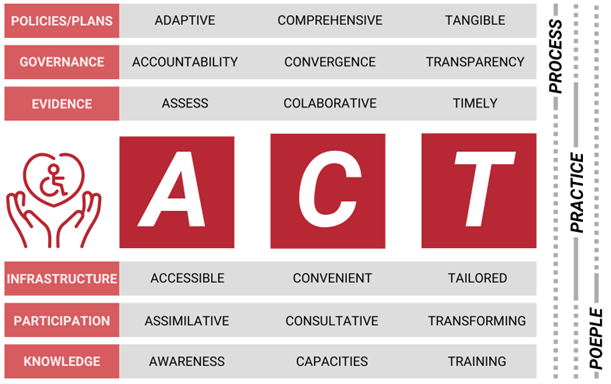Developing localised strategies for Disability Inclusive Urban Resilience

Renowned for its rich cultural heritage, Odisha also bears the brunt of nature's fury. In the last 100 years, a total of 260 cyclones have confronted the state, leading to mass destruction and loss of lives. While disaster preparedness has drastically reduced the number of deaths, cyclones have had multi-fold impacts on lives, including displacement, damage to houses and loss of livelihood. Despite strides in resilience, the toll of these storms remains devastating, especially for Persons with Disabilities.
The impact of cyclones, like any disaster, is often proportional to the individual’s, community’s and city’s vulnerability to react and absorb the stresses. These vulnerabilities will increase due to several intersecting factors that are usually socially constructed: “underlying drivers of social vulnerability such as gender, social status, age, race and ethnicity, and wealth”. It is a fact that a combination of attitudinal, financial, physical, and communication barriers increase the vulnerabilities of marginalized demographics including persons with disabilities. Inaccessibility in cyclone shelters and information dissemination including the early warning systems, prevalence of poverty among persons with disabilities, lack of awareness and sensitisation of the communities, frontline workers and officials to include the needs of persons with disabilities, exponentially increases the impact of disasters. The high density, informality, and complexity of urban areas further exacerbate their vulnerability.
The Sendai Framework and Incheon Strategy have emphasised disability-inclusive disaster risk reduction. The National Disaster Management Guideline on Disability Inclusive Disaster Risk Reduction, published by NDMA in 2019, highlights the need for a disability-inclusive approach at every stage of the project cycle. The CDRI fellowship project - Strategic Actions for Building Resilience for ALL aims at mainstreaming the inclusion of persons with disabilities in disaster management, echoing the principles of “Leave No One Behind”. The project identifies the principle highlighted in the national guidelines as parameters for assessment of the state of inclusion in disaster management strategies in selected areas.
Ganjam District of Odisha, the most populous and one of the most vulnerable districts to cyclones, has more than 2.96% (census 2011) of the population being persons with disabilities. Stretching across more than 1/8th of the total coastline of Odisha, the district encompasses 18 urban areas, many of which are impacted by cyclones. Gopalpur, a small seaside urban area has been the centre site of landfall of many cyclones in the past, and Berhampur, the only municipal corporation in the district, is the largest and most complex urban area in the district. These have been selected to pilot the study. Adopting a comprehensive approach, the study evaluates all three critical components - system, infrastructure, and people. Insights were drawn from primary surveys conducted at the household level, focused group discussions, accessibility audits, and interviews/interactions with relevant stakeholders.
The recent vulnerability assessment in the cities of Berhampur and Gopalpur revealed some striking findings. Nearly every respondent had faced a cyclone in their lifetime, and yet less than 5 % of respondents had a disaster preparedness plan and over two third of the respondents faced difficulty in evacuation. Over 80% of the respondents didn’t find the relief shelters conducive to their special needs. Key concerns identified include limited knowledge and capacity building among citizens, community groups, and officials, lack of participation of persons with disabilities in decision-making and policy-making, weak preparedness and mitigation measures among the populace, and the absence of universally accessible infrastructures.
Focus group discussions (FGDs) were conducted, bringing together men, women, and children with disabilities, along with their caregivers. These sessions went beyond mere data collection; they were meaningful exchanges where voices, often unheard, found resonance. The pressing need to address the special requirements of marginalized groups in cyclone shelters, early warning systems, evacuation processes, and relief provisions was reiterated across all groups. These insights underscore the need for inclusive disaster management strategies that cater specifically to the needs of persons with disabilities, ensuring their safety and well-being during disasters.
The interviews highlighted a strong government intent to support the most vulnerable and marginalized. However, it was realized that while top-down policies are essential for change, they often fail to translate into tangible, actionable steps at the grassroots level. To address these challenges, the findings indicate the need for six key areas for action:
- Participation (People)
- Knowledge (People)
- Evidence (Practice)
- Infrastructure (Practice)
- Policies/Plans (Process)
- Governance (Process)
Actions for the three Ps—people, practice, and process—should be developed at the community level. Developing community-level networks, inventories, action plans, and standard operating procedures (SOPs) can expedite the inclusion of PwDs in disaster management.
Empowering PwDs to voice their needs and act as agents of change is critical. This approach not only addresses their unique challenges but also underscores the power of inclusive resilience. By fostering community-level initiatives and ensuring the active participation of PwDs in disaster management, we can create a more inclusive and resilient society.
By- Kanika Bansal & Utsav Choudhury, NIUA, India, CDRI Fellows 2023-24
The views and opinions expressed in this blog are those of the authors and do not necessarily reflect those of the Coalition for Disaster Resilient Infrastructure (CDRI).




